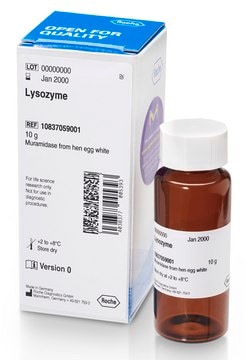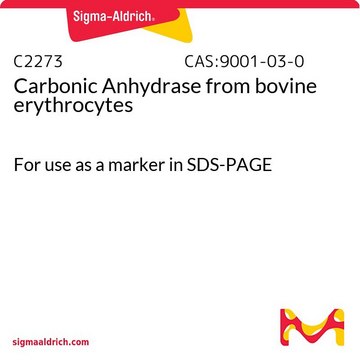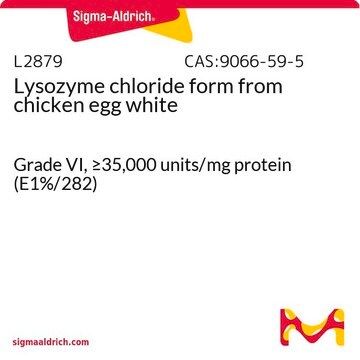L4631
Lysozyme from chicken egg white
For use as a marker in SDS-PAGE
Synonym(s):
Mucopeptide N-acetylmuramoylhydrolase, Muramidase
Sign Into View Organizational & Contract Pricing
All Photos(1)
About This Item
CAS Number:
EC Number:
MDL number:
UNSPSC Code:
12352204
NACRES:
NA.54
Recommended Products
biological source
chicken egg white
Quality Level
form
powder
mol wt
single-chain 14.3 kDa
packaging
vial of 25 mg
UniProt accession no.
storage temp.
2-8°C
Gene Information
chicken ... LYZ(396218)
Looking for similar products? Visit Product Comparison Guide
Related Categories
Application
Enzyme breaks down the cell walls of bacteria; used to prepare spheroplasts.
Biochem/physiol Actions
Lysozyme hydrolyzes β(1→4) linkages between N-acetylmuramic acid and N-acetyl-D-glucosamine residues in peptidoglycan and between N-acetyl-D-glucosamine residues in chitodextrin. Gram-positive cells are quite susceptible to this hydrolysis as their cell walls have a high proportion of peptidoglycan. Gram-negative bacteria are less susceptible due to the presence of an outer membrane and a lower proportion of peptidoglycan. However, these cells may be hydrolyzed in the presence of EDTA that chelates metal ions in the outer bacterial membrane.
The enzyme is active over a broad pH range (6.0 to 9.0). At pH 6.2, maximal activity is observed over a wider range of ionic strengths (0.02 to 0.100 M) than at pH 9.2 (0.01 to 0.06 M).
The enzyme is active over a broad pH range (6.0 to 9.0). At pH 6.2, maximal activity is observed over a wider range of ionic strengths (0.02 to 0.100 M) than at pH 9.2 (0.01 to 0.06 M).
Unit Definition
One unit will lyse 0.6 μg of Micrococcus lysodeikticus per minute by turbidimetric detection at 600 nm when suspended in buffer at pH 6.2 at 25 °C.
Signal Word
Danger
Hazard Statements
Precautionary Statements
Hazard Classifications
Resp. Sens. 1
Storage Class Code
11 - Combustible Solids
WGK
WGK 3
Flash Point(F)
Not applicable
Flash Point(C)
Not applicable
Personal Protective Equipment
dust mask type N95 (US), Eyeshields, Gloves
Certificates of Analysis (COA)
Search for Certificates of Analysis (COA) by entering the products Lot/Batch Number. Lot and Batch Numbers can be found on a product’s label following the words ‘Lot’ or ‘Batch’.
Already Own This Product?
Find documentation for the products that you have recently purchased in the Document Library.
Customers Also Viewed
Enav Bar Shira et al.
PloS one, 13(7), e0200393-e0200393 (2018-07-07)
Intestinal epithelial cells are multi-tasked cells that participate in digestion and absorption as well as in protection of the digestive tract. While information on the physiology and immune functions of intestinal epithelial cells in mammals is abundant, little is known
Zhe Wang et al.
The journal of physical chemistry. B, 117(4), 1186-1195 (2013-01-11)
High-resolution inelastic X-ray scattering was used to investigate the collective vibrational excitations in hydrated lysozyme powders as a function of hydration level and temperature. It is found that the samples with strong enzymatic function are "soft", in the sense that
Sven O Dahms et al.
Acta crystallographica. Section D, Biological crystallography, 69(Pt 2), 284-297 (2013-02-07)
Heavy-atom clusters (HA clusters) containing a large number of specifically arranged electron-dense scatterers are especially useful for experimental phase determination of large complex structures, weakly diffracting crystals or structures with large unit cells. Often, the determination of the exact orientation
Yashwanth Ashok et al.
Methods in enzymology, 520, 175-198 (2013-01-22)
G-protein-coupled receptors (GPCRs) represent a major class of receptors through which a number of signals ranging from photons to large glycoprotein hormones are recognized. Human genome encodes about 800 GPCRs, yet very little structural information is available on this class
Masaki Honda et al.
Transplantation, 95(4), 551-558 (2013-02-21)
Neutrophils are considered responsible for the pathophysiologic changes during hepatic ischemia-reperfusion (I/R) injury; however, few studies have examined real-time intravital neutrophil recruitment. Here, we show a method for imaging the neutrophil recruitment in hepatic I/R injury using two-photon laser scanning
Chromatograms
application for HPLCOur team of scientists has experience in all areas of research including Life Science, Material Science, Chemical Synthesis, Chromatography, Analytical and many others.
Contact Technical Service







